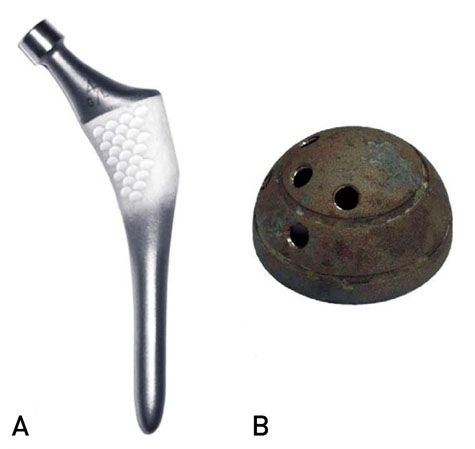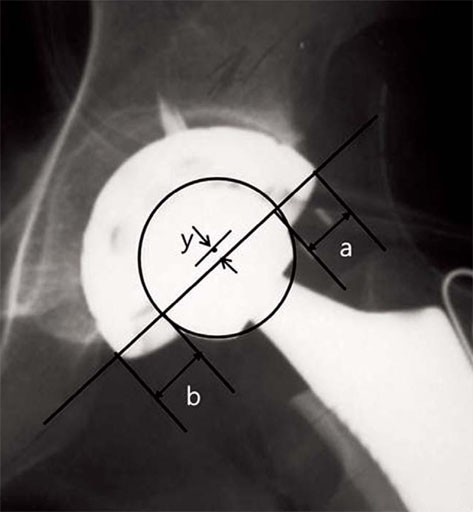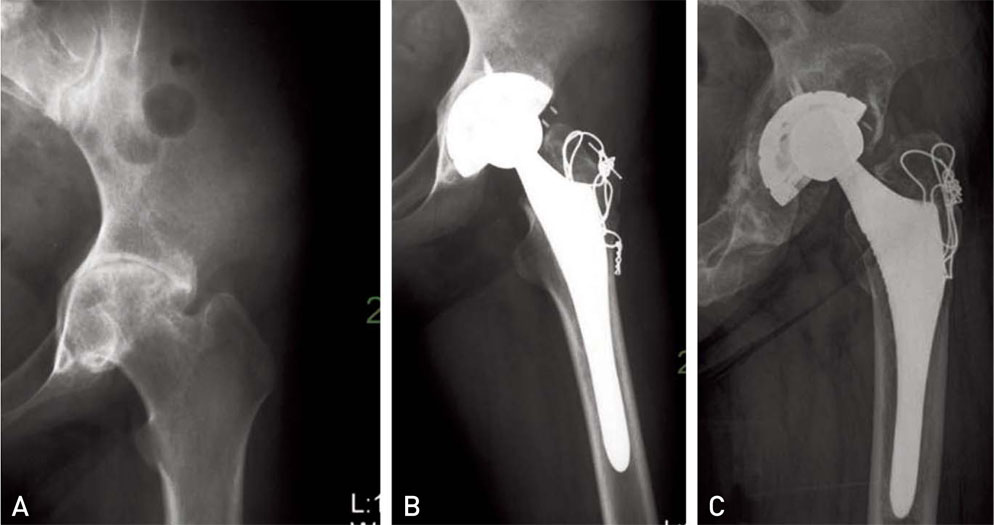Hip Pelvis.
2013 Sep;25(3):166-172. 10.5371/hp.2013.25.3.166.
Cementless Total Hip Arthroplasty Using the ABG I Hydroxyapatite-coated Prosthesis: Minimum 10 Year Follow-up
- Affiliations
-
- 1Department of Orthopedic Surgery, Hanyang University Hospital, Seoul, Korea.
- 2Department of Orthopedic Surgery, Hanyang University Guri Hospital, Guri, Korea. kimyh1@hanyang.ac.kr
- KMID: 1974371
- DOI: http://doi.org/10.5371/hp.2013.25.3.166
Abstract
- PURPOSE
The purpose of this study was to evaluate the outcomes of total hip arthroplasty (THA) with an ABG I hip prosthesis after a minimum ten-year follow up.
MATERIALS AND METHODS
From January 1996 to March 2001, 121 hips in 104 patients, whi were followed up for a minimum of ten-years, were enrolled in this study. The clinical and radiographic outcomes were evaluated and Kaplan-Meier survival analysis was performed.
RESULTS
The mean Harris hip score at the last follow-up was 84 points. A radiolucent line around the cup, osteolysis, and cup loosening were observed in 5 hips(4.1%), 53 hips(43.8%), and 5 hips(4.1%), respectively. In the femoral side, osteolysis and stem loosening were observed in 11 hips(9.1%) and 2 hips(1.7%), respectively. The mean linear wear rate of the polyethylene liner was 0.23 mm/yr. Forty four revisions(36.3%) were performed. The outcomes were similar regardless of the cause of primary THA. The survival rate with the end point of revision due to cup loosening was 56.3%, and revision due to stem loosening was 98.1% after a 16 year follow-up.
CONCLUSION
High polyethylene wear and the disappointing survival rate of the ABGI cup were observed after a minimum ten year follow-up. Therefore, close observation of patients who have received an ABG I prosthesis is necessary.
Keyword
MeSH Terms
Figure
Reference
-
1. Rossi P, Sibelli P, Fumero S, Crua E. Short-term results of hydroxyapatite-coated primary total hip arthroplasty. Clin Orthop Relat Res. 1995; (310):98–102.
Article2. Tonino AJ, Romanini L, Rossi P, et al. Hydroxyapatite-coated hip prostheses. Early results from an international study. Clin Orthop Relat Res. 1995; (312):211–225.3. Duffy P, Sher JL, Partington PF. Premature wear and osteolysis in an HA-coated, uncemented total hip arthroplasty. J Bone Joint Surg Br. 2004; 86:34–38.
Article4. Chung YY, Ki SC, So KY, Kim DH, Park KH, Lee YS. High revision rate of hydroxyapatite-coated ABG-I prosthesis. J Orthop Sci. 2009; 14:543–547.
Article5. Gallo J, Havranek V, Zapletalova J, Lostak J. Male gender, Charnley class C, and severity of bone defects predict the risk for aseptic loosening in the cup of ABG I hip arthroplasty. BMC Musculoskelet Disord. 2010; 11:243.
Article6. DeLee JG, Charnley J. Radiological demarcation of cemented sockets in total hip replacement. Clin Orthop Relat Res. 1976; (121):20–32.
Article7. Gruen TA, McNeice GM, Amstutz HC. "Modes of failure" of cemented stem-type femoral components: a radiographic analysis of loosening. Clin Orthop Relat Res. 1979; (141):17–27.8. Bierbaum BE, Nairus J, Kuesis D, Morrison JC, Ward D. Ceramic-on-ceramic bearings in total hip arthroplasty. Clin Orthop Relat Res. 2002; (405):158–163.
Article9. Zicat B, Engh CA, Gokcen E. Patterns of osteolysis around total hip components inserted with and without cement. J Bone Joint Surg Am. 1995; 77:432–439.
Article10. Callaghan JJ, Dysart SH, Savory CG. The uncemented porous-coated anatomic total hip prosthesis. Two-year results of a prospective consecutive series. J Bone Joint Surg Am. 1988; 70:337–346.
Article11. Ilchmann T, Mjöberg B, Wingstrand H. Measurement accuracy in acetabular cup wear. Three retrospective methods compared with Roentgen stereophotogrammetry. J Arthroplasty. 1995; 10:636–642.12. Brooker AF, Bowerman JW, Robinson RA, Riley LH Jr. Ectopic ossification following total hip replacement. Incidence and a method of classification. J Bone Joint Surg Am. 1973; 55:1629–1632.13. Furlong RJ, Osborn JF. Fixation of hip prostheses by hydroxyapatite ceramic coatings. J Bone Joint Surg Br. 1991; 73:741–745.
Article14. Giannikas KA, Din R, Sadiq S, Dunningham TH. Medium-term results of the ABG total hip arthroplasty in young patients. J Arthroplasty. 2002; 17:184–188.
Article15. Morscher EW, Hefti A, Aebi U. Severe osteolysis after third-body wear due to hydroxyapatite particles from acetabular cup coating. J Bone Joint Surg Br. 1998; 80:267–272.
Article16. McKellop H, Shen FW, Lu B, Campbell P, Salovey R. Effect of sterilization method and other modifications on the wear resistance of acetabular cups made of ultra-high molecular weight polyethylene. A hip-simulator study. J Bone Joint Surg Am. 2000; 82:1708–1725.
Article17. Sutula LC, Collier JP, Saum KA, et al. The Otto Aufranc Award. Impact of gamma sterilization on clinical performance of polyethylene in the hip. Clin Orthop Relat Res. 1995; (319):28–40.18. Cooper RA, McAllister CM, Borden LS, Bauer TW. Polyethylene debris-induced osteolysis and loosening in uncemented total hip arthroplasty. A cause of late failure. J Arthroplasty. 1992; 7:285–290.
Article19. Delank KS, Drees P, Menzel N, Hansen T, Duschner H, Eckardt A. Increased polyethylene wear after cementless ABG I total hip arthroplasty. Arch Orthop Trauma Surg. 2006; 126:509–516.
Article20. Koh KH, Moon YW, Lim SJ, Lee HI, Shim JW, Park YS. Complete acetabular cup revision versus isolated liner exchange for polyethylene wear and osteolysis without loosening in cementless total hip arthroplasty. Arch Orthop Trauma Surg. 2011; 131:1591–1600.
Article21. Haugeberg G, Uhlig T, Falch JA, Halse JI, Kvien TK. Reduced bone mineral density in male rheumatoid arthritis patients: frequencies and associations with demographic and disease variables in ninety-four patients in the Oslo County Rheumatoid Arthritis Register. Arthritis Rheum. 2000; 43:2776–2784.
Article22. Keisu KS, Orozco F, McCallum JD 3rd, et al. Cementless femoral fixation in the rheumatoid patient undergoing total hip arthroplasty: minimum 5-year results. J Arthroplasty. 2001; 16:415–421.
Article23. Meding JB, Galley MR, Ritter MA. High survival of uncemented proximally porous-coated titanium alloy femoral stems in osteoporotic bone. Clin Orthop Relat Res. 2010; 468:441–447.
Article24. Engvall IL, Svensson B, Tengstrand B, Brismar K, Hafström I. Impact of low-dose prednisolone on bone synthesis and resorption in early rheumatoid arthritis: experiences from a two-year randomized study. Arthritis Res Ther. 2008; 10:R128.25. Rienstra W, van der Veen HC, van den Akker Scheek I, van Raay JJ. Clinical outcome, survival and polyethylene wear of an uncemented total hip arthroplasty: a 10- to 12-year follow-up study of 81 hips. J Arthroplasty. 2013; 28:1362–1366.
Article26. Gottliebsen M, Rahbek O, Ottosen PF, Søballe K, Stilling M. Superior 11-year survival but higher polyethylene wear of hydroxyapatite-cated Mallory-Head cups. Hip Int. 2012; 22:35–40.
Article27. de Witte PB, Brand R, Vermeer HG, van der Heide HJ, Barnaart AF. Mid-term results of total hip arthroplasty with the CementLess Spotorno (CLS) system. J Bone Joint Surg Am. 2011; 93:1249–1255.
Article28. Saito S, Ishii T, Mori S, Hosaka K, Tokuhashi Y. The Harris-Galante cementless THA: a 19- to 25-year follow-up study. Orthopedics. 2011; 34:12.
Article29. Emms NW, Stockley I, Hamer AJ, Wilkinson JM. Long-term outcome of a cementless, hemispherical, press-fit acetabular component: survivorship analysis and dose-response relationship to linear polyethylene wear. J Bone Joint Surg Br. 2010; 92:856–861.
- Full Text Links
- Actions
-
Cited
- CITED
-
- Close
- Share
- Similar articles
-
- Total Hip Arthroplasty with Hydroxyapatite-coated ABG(R) Hip Prosthesis: Minimum 5 Year Follow-up
- Minimum Five Year Follow-Up Study of Porous-Coated Versus Hydroxyapatite Porous-Coated Cementless Total Hip Replacement
- Clinical and Radiologic Results of Cementless Total Hip Arthroplasty Using Hydroxyapatite - Coated Stem
- Total Hip Arthroplasty with Hydroxyapatite-Coated Cementless Acetabular Cup : Minimum 10-Year Follow-up Result
- Short-term Results after Cementless Total Hip Arthroplasty Using a Fully Hydroxyapatite-coated Femoral Stem





